Early Childhood Education Curriculum and Pedagogical Approaches Report
VerifiedAdded on 2021/05/30
|6
|1347
|93
Report
AI Summary
This report presents a summary and analysis of an interview conducted with an early childhood education practitioner with seven years of experience teaching Kindergarten in Abu Dhabi, UAE. The interview explored various aspects of early childhood education, including curriculum planning, implementation, learner observations, record-keeping, and challenges faced by educators. The practitioner discussed her approach to differentiating activities, planning short, medium, and long-term learning experiences, and utilizing observations and assessments to track student progress. A significant focus of the report is the discussion of the heavy workload faced by kindergarten teachers, highlighting its potential impact on teacher effectiveness and well-being. The report references relevant studies and research to support the findings, emphasizing the importance of addressing these challenges to create a conducive learning environment for both teachers and students.
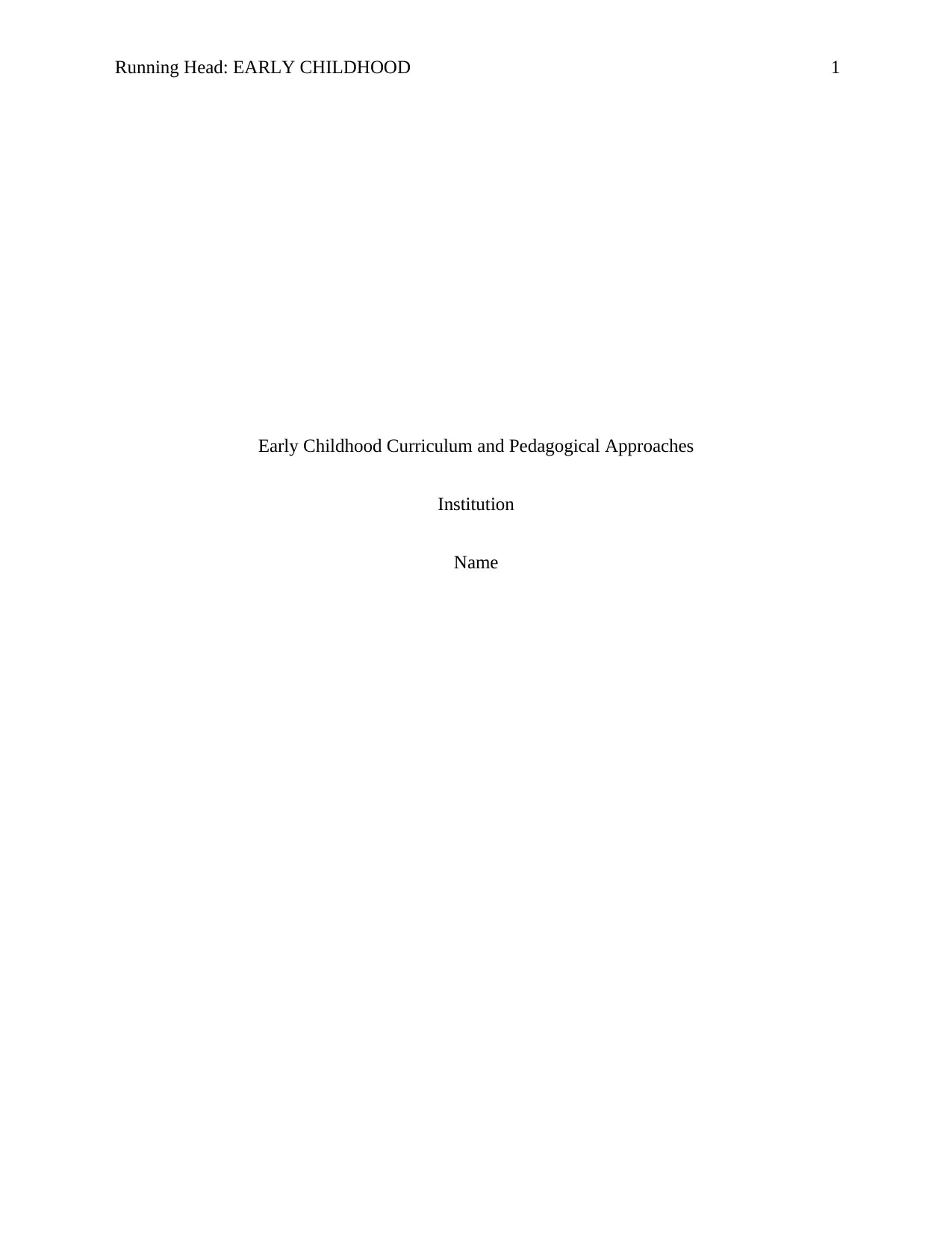
Running Head: EARLY CHILDHOOD 1
Early Childhood Curriculum and Pedagogical Approaches
Institution
Name
Early Childhood Curriculum and Pedagogical Approaches
Institution
Name
Paraphrase This Document
Need a fresh take? Get an instant paraphrase of this document with our AI Paraphraser
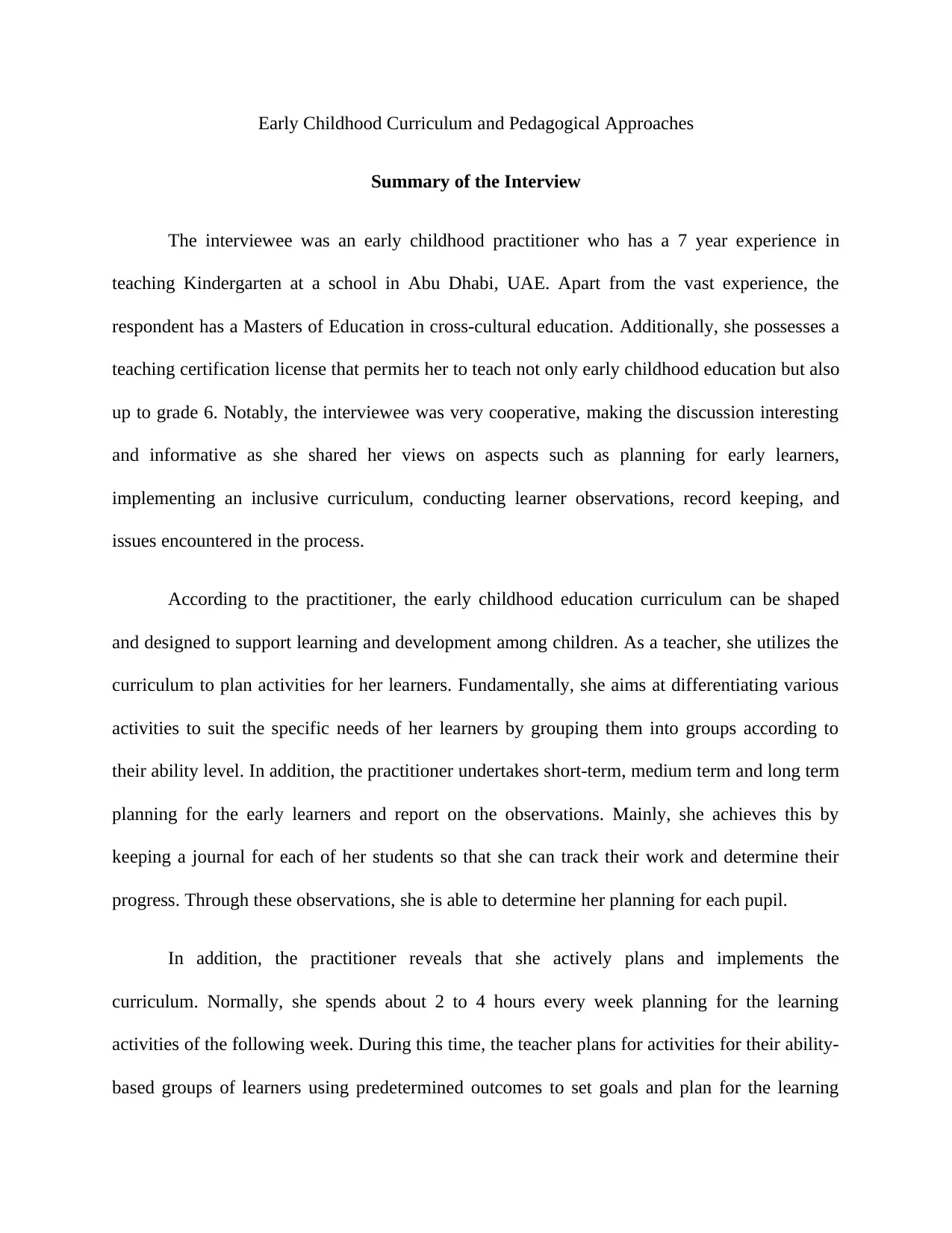
Early Childhood Curriculum and Pedagogical Approaches
Summary of the Interview
The interviewee was an early childhood practitioner who has a 7 year experience in
teaching Kindergarten at a school in Abu Dhabi, UAE. Apart from the vast experience, the
respondent has a Masters of Education in cross-cultural education. Additionally, she possesses a
teaching certification license that permits her to teach not only early childhood education but also
up to grade 6. Notably, the interviewee was very cooperative, making the discussion interesting
and informative as she shared her views on aspects such as planning for early learners,
implementing an inclusive curriculum, conducting learner observations, record keeping, and
issues encountered in the process.
According to the practitioner, the early childhood education curriculum can be shaped
and designed to support learning and development among children. As a teacher, she utilizes the
curriculum to plan activities for her learners. Fundamentally, she aims at differentiating various
activities to suit the specific needs of her learners by grouping them into groups according to
their ability level. In addition, the practitioner undertakes short-term, medium term and long term
planning for the early learners and report on the observations. Mainly, she achieves this by
keeping a journal for each of her students so that she can track their work and determine their
progress. Through these observations, she is able to determine her planning for each pupil.
In addition, the practitioner reveals that she actively plans and implements the
curriculum. Normally, she spends about 2 to 4 hours every week planning for the learning
activities of the following week. During this time, the teacher plans for activities for their ability-
based groups of learners using predetermined outcomes to set goals and plan for the learning
Summary of the Interview
The interviewee was an early childhood practitioner who has a 7 year experience in
teaching Kindergarten at a school in Abu Dhabi, UAE. Apart from the vast experience, the
respondent has a Masters of Education in cross-cultural education. Additionally, she possesses a
teaching certification license that permits her to teach not only early childhood education but also
up to grade 6. Notably, the interviewee was very cooperative, making the discussion interesting
and informative as she shared her views on aspects such as planning for early learners,
implementing an inclusive curriculum, conducting learner observations, record keeping, and
issues encountered in the process.
According to the practitioner, the early childhood education curriculum can be shaped
and designed to support learning and development among children. As a teacher, she utilizes the
curriculum to plan activities for her learners. Fundamentally, she aims at differentiating various
activities to suit the specific needs of her learners by grouping them into groups according to
their ability level. In addition, the practitioner undertakes short-term, medium term and long term
planning for the early learners and report on the observations. Mainly, she achieves this by
keeping a journal for each of her students so that she can track their work and determine their
progress. Through these observations, she is able to determine her planning for each pupil.
In addition, the practitioner reveals that she actively plans and implements the
curriculum. Normally, she spends about 2 to 4 hours every week planning for the learning
activities of the following week. During this time, the teacher plans for activities for their ability-
based groups of learners using predetermined outcomes to set goals and plan for the learning
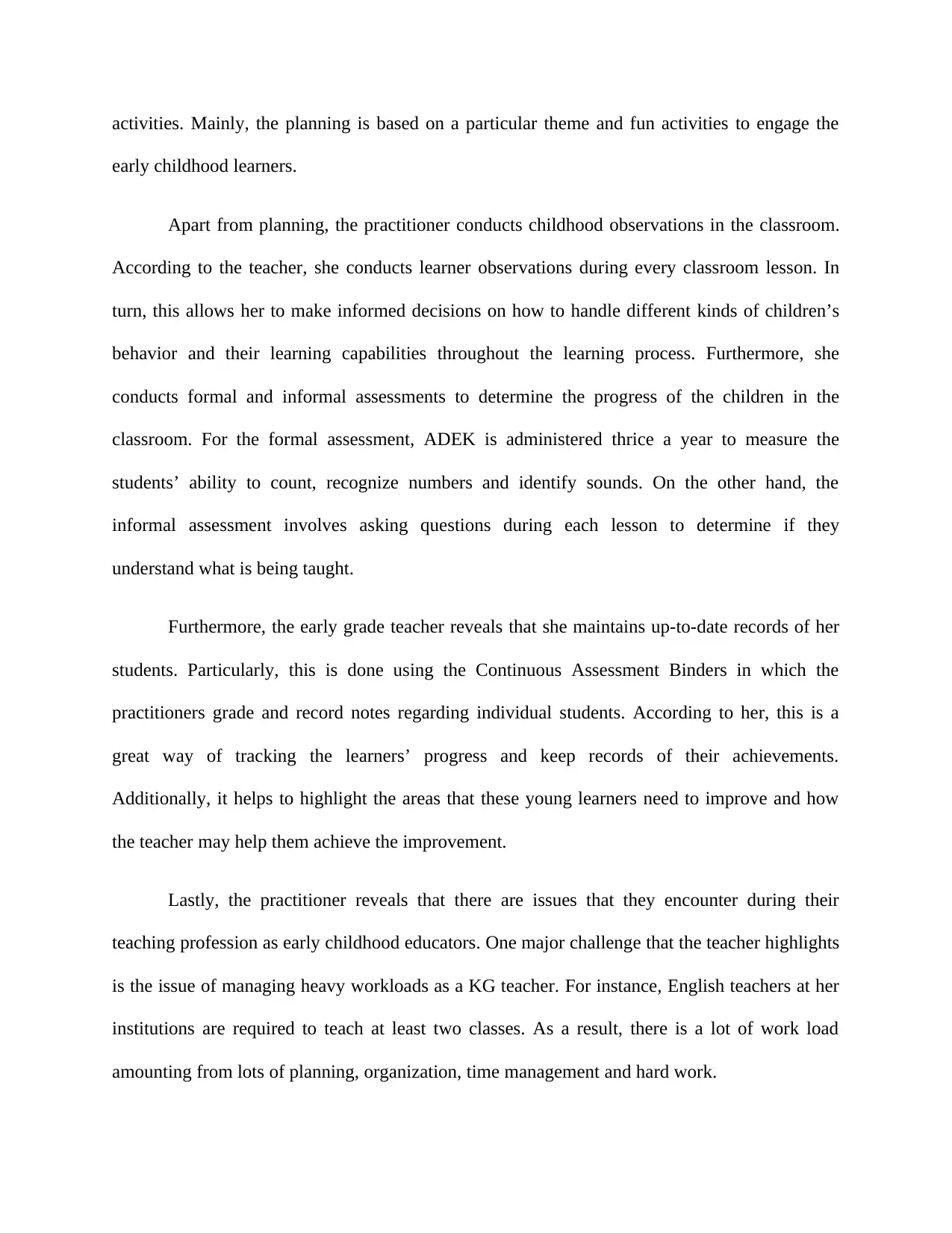
activities. Mainly, the planning is based on a particular theme and fun activities to engage the
early childhood learners.
Apart from planning, the practitioner conducts childhood observations in the classroom.
According to the teacher, she conducts learner observations during every classroom lesson. In
turn, this allows her to make informed decisions on how to handle different kinds of children’s
behavior and their learning capabilities throughout the learning process. Furthermore, she
conducts formal and informal assessments to determine the progress of the children in the
classroom. For the formal assessment, ADEK is administered thrice a year to measure the
students’ ability to count, recognize numbers and identify sounds. On the other hand, the
informal assessment involves asking questions during each lesson to determine if they
understand what is being taught.
Furthermore, the early grade teacher reveals that she maintains up-to-date records of her
students. Particularly, this is done using the Continuous Assessment Binders in which the
practitioners grade and record notes regarding individual students. According to her, this is a
great way of tracking the learners’ progress and keep records of their achievements.
Additionally, it helps to highlight the areas that these young learners need to improve and how
the teacher may help them achieve the improvement.
Lastly, the practitioner reveals that there are issues that they encounter during their
teaching profession as early childhood educators. One major challenge that the teacher highlights
is the issue of managing heavy workloads as a KG teacher. For instance, English teachers at her
institutions are required to teach at least two classes. As a result, there is a lot of work load
amounting from lots of planning, organization, time management and hard work.
early childhood learners.
Apart from planning, the practitioner conducts childhood observations in the classroom.
According to the teacher, she conducts learner observations during every classroom lesson. In
turn, this allows her to make informed decisions on how to handle different kinds of children’s
behavior and their learning capabilities throughout the learning process. Furthermore, she
conducts formal and informal assessments to determine the progress of the children in the
classroom. For the formal assessment, ADEK is administered thrice a year to measure the
students’ ability to count, recognize numbers and identify sounds. On the other hand, the
informal assessment involves asking questions during each lesson to determine if they
understand what is being taught.
Furthermore, the early grade teacher reveals that she maintains up-to-date records of her
students. Particularly, this is done using the Continuous Assessment Binders in which the
practitioners grade and record notes regarding individual students. According to her, this is a
great way of tracking the learners’ progress and keep records of their achievements.
Additionally, it helps to highlight the areas that these young learners need to improve and how
the teacher may help them achieve the improvement.
Lastly, the practitioner reveals that there are issues that they encounter during their
teaching profession as early childhood educators. One major challenge that the teacher highlights
is the issue of managing heavy workloads as a KG teacher. For instance, English teachers at her
institutions are required to teach at least two classes. As a result, there is a lot of work load
amounting from lots of planning, organization, time management and hard work.
⊘ This is a preview!⊘
Do you want full access?
Subscribe today to unlock all pages.

Trusted by 1+ million students worldwide
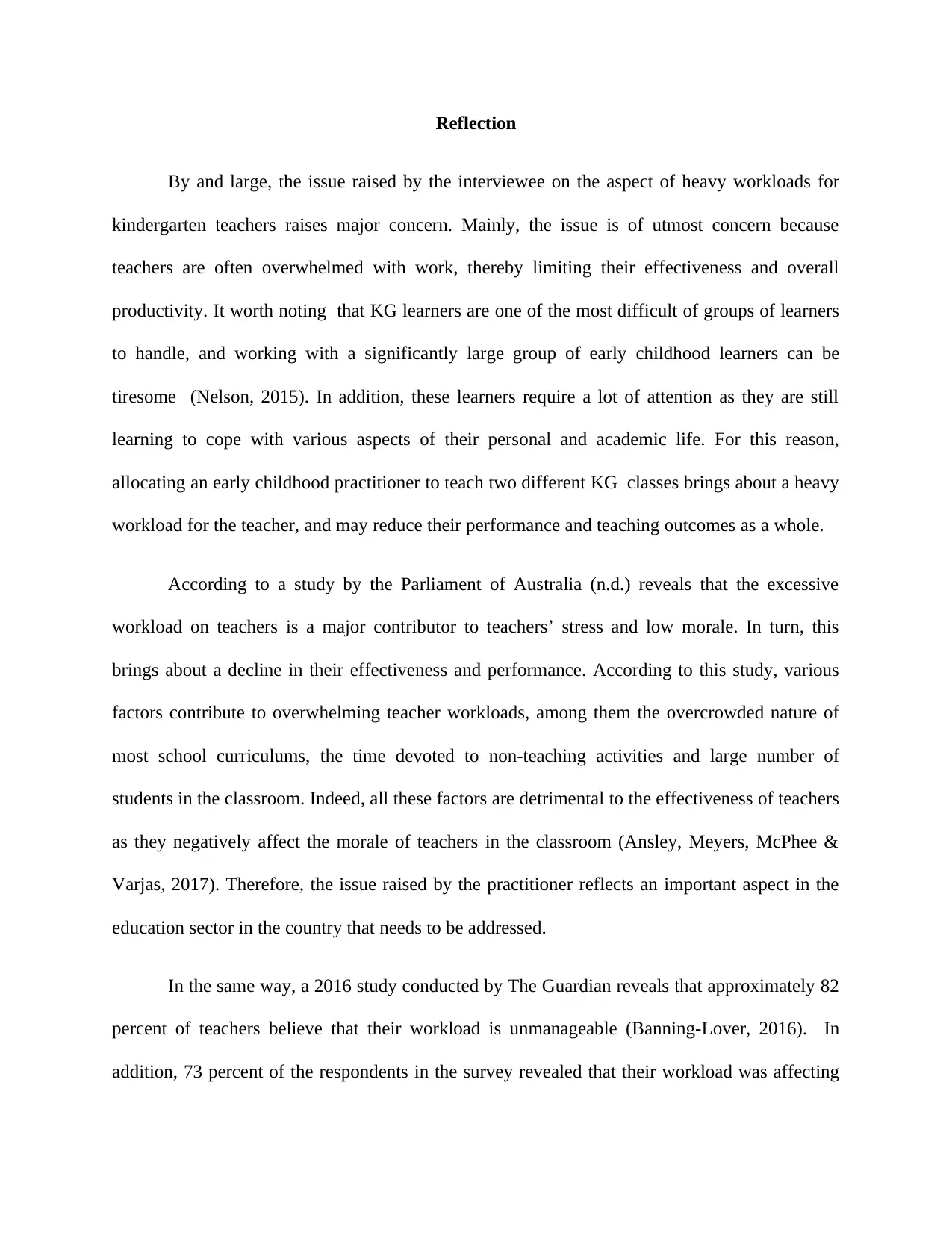
Reflection
By and large, the issue raised by the interviewee on the aspect of heavy workloads for
kindergarten teachers raises major concern. Mainly, the issue is of utmost concern because
teachers are often overwhelmed with work, thereby limiting their effectiveness and overall
productivity. It worth noting that KG learners are one of the most difficult of groups of learners
to handle, and working with a significantly large group of early childhood learners can be
tiresome (Nelson, 2015). In addition, these learners require a lot of attention as they are still
learning to cope with various aspects of their personal and academic life. For this reason,
allocating an early childhood practitioner to teach two different KG classes brings about a heavy
workload for the teacher, and may reduce their performance and teaching outcomes as a whole.
According to a study by the Parliament of Australia (n.d.) reveals that the excessive
workload on teachers is a major contributor to teachers’ stress and low morale. In turn, this
brings about a decline in their effectiveness and performance. According to this study, various
factors contribute to overwhelming teacher workloads, among them the overcrowded nature of
most school curriculums, the time devoted to non-teaching activities and large number of
students in the classroom. Indeed, all these factors are detrimental to the effectiveness of teachers
as they negatively affect the morale of teachers in the classroom (Ansley, Meyers, McPhee &
Varjas, 2017). Therefore, the issue raised by the practitioner reflects an important aspect in the
education sector in the country that needs to be addressed.
In the same way, a 2016 study conducted by The Guardian reveals that approximately 82
percent of teachers believe that their workload is unmanageable (Banning-Lover, 2016). In
addition, 73 percent of the respondents in the survey revealed that their workload was affecting
By and large, the issue raised by the interviewee on the aspect of heavy workloads for
kindergarten teachers raises major concern. Mainly, the issue is of utmost concern because
teachers are often overwhelmed with work, thereby limiting their effectiveness and overall
productivity. It worth noting that KG learners are one of the most difficult of groups of learners
to handle, and working with a significantly large group of early childhood learners can be
tiresome (Nelson, 2015). In addition, these learners require a lot of attention as they are still
learning to cope with various aspects of their personal and academic life. For this reason,
allocating an early childhood practitioner to teach two different KG classes brings about a heavy
workload for the teacher, and may reduce their performance and teaching outcomes as a whole.
According to a study by the Parliament of Australia (n.d.) reveals that the excessive
workload on teachers is a major contributor to teachers’ stress and low morale. In turn, this
brings about a decline in their effectiveness and performance. According to this study, various
factors contribute to overwhelming teacher workloads, among them the overcrowded nature of
most school curriculums, the time devoted to non-teaching activities and large number of
students in the classroom. Indeed, all these factors are detrimental to the effectiveness of teachers
as they negatively affect the morale of teachers in the classroom (Ansley, Meyers, McPhee &
Varjas, 2017). Therefore, the issue raised by the practitioner reflects an important aspect in the
education sector in the country that needs to be addressed.
In the same way, a 2016 study conducted by The Guardian reveals that approximately 82
percent of teachers believe that their workload is unmanageable (Banning-Lover, 2016). In
addition, 73 percent of the respondents in the survey revealed that their workload was affecting
Paraphrase This Document
Need a fresh take? Get an instant paraphrase of this document with our AI Paraphraser
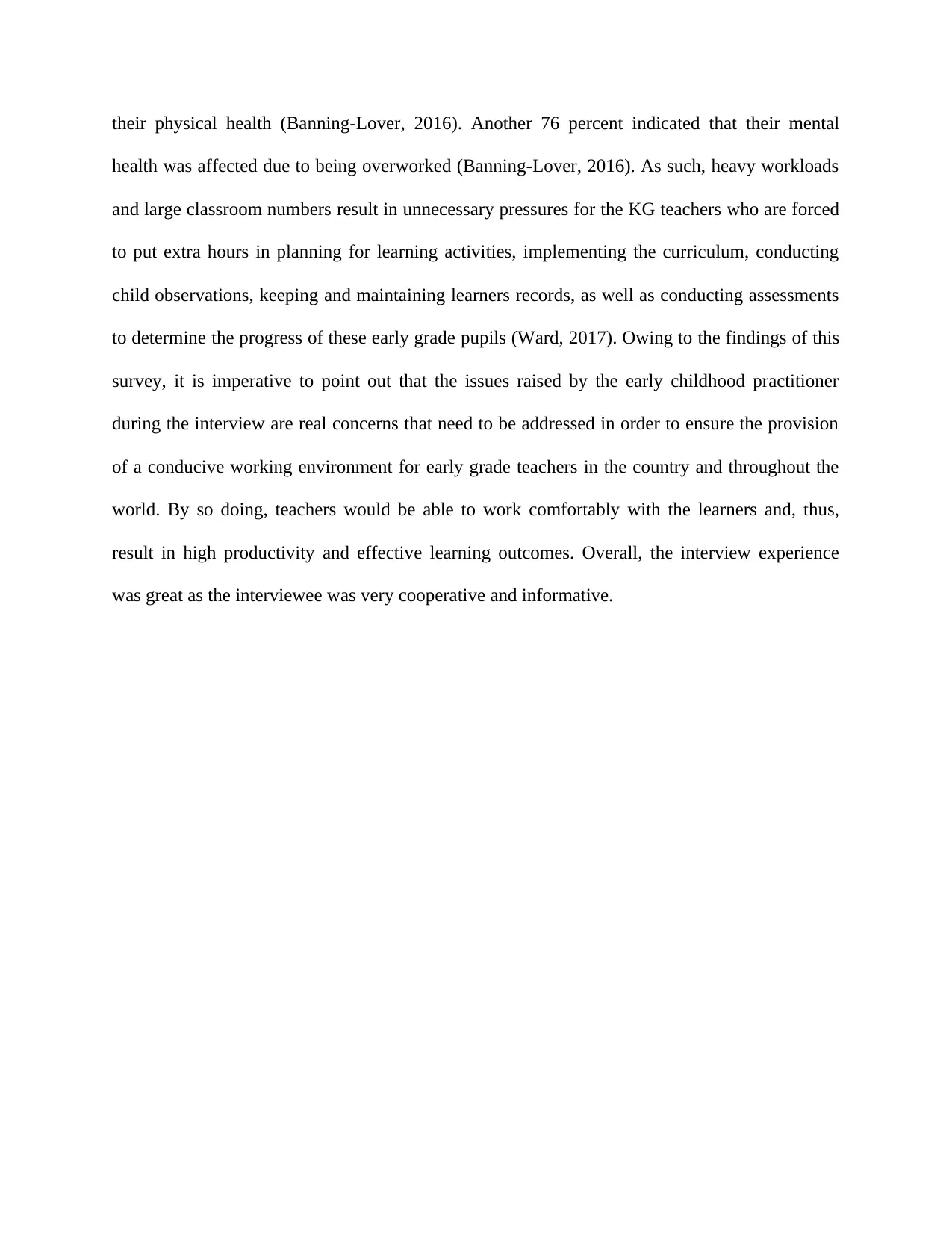
their physical health (Banning-Lover, 2016). Another 76 percent indicated that their mental
health was affected due to being overworked (Banning-Lover, 2016). As such, heavy workloads
and large classroom numbers result in unnecessary pressures for the KG teachers who are forced
to put extra hours in planning for learning activities, implementing the curriculum, conducting
child observations, keeping and maintaining learners records, as well as conducting assessments
to determine the progress of these early grade pupils (Ward, 2017). Owing to the findings of this
survey, it is imperative to point out that the issues raised by the early childhood practitioner
during the interview are real concerns that need to be addressed in order to ensure the provision
of a conducive working environment for early grade teachers in the country and throughout the
world. By so doing, teachers would be able to work comfortably with the learners and, thus,
result in high productivity and effective learning outcomes. Overall, the interview experience
was great as the interviewee was very cooperative and informative.
health was affected due to being overworked (Banning-Lover, 2016). As such, heavy workloads
and large classroom numbers result in unnecessary pressures for the KG teachers who are forced
to put extra hours in planning for learning activities, implementing the curriculum, conducting
child observations, keeping and maintaining learners records, as well as conducting assessments
to determine the progress of these early grade pupils (Ward, 2017). Owing to the findings of this
survey, it is imperative to point out that the issues raised by the early childhood practitioner
during the interview are real concerns that need to be addressed in order to ensure the provision
of a conducive working environment for early grade teachers in the country and throughout the
world. By so doing, teachers would be able to work comfortably with the learners and, thus,
result in high productivity and effective learning outcomes. Overall, the interview experience
was great as the interviewee was very cooperative and informative.
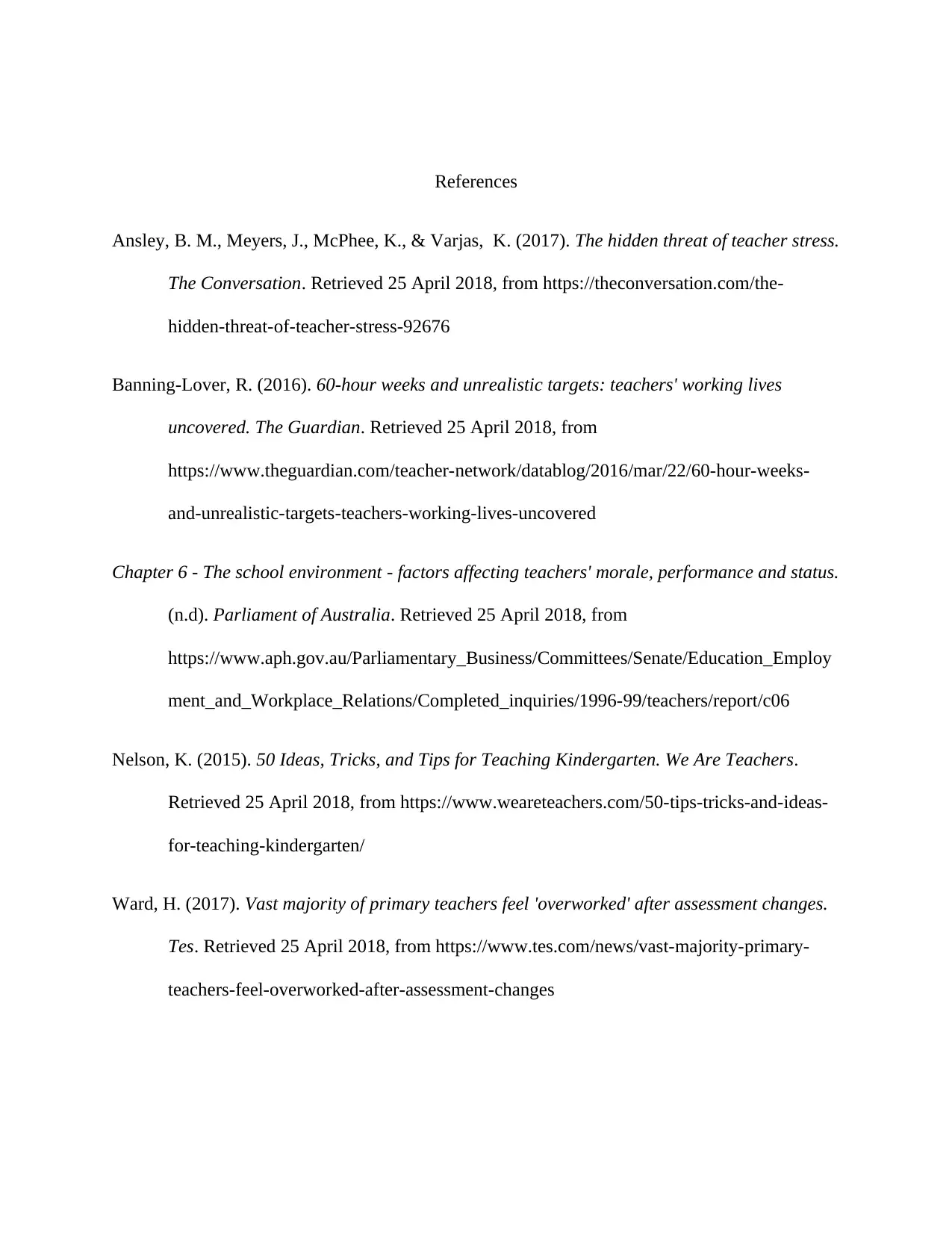
References
Ansley, B. M., Meyers, J., McPhee, K., & Varjas, K. (2017). The hidden threat of teacher stress.
The Conversation. Retrieved 25 April 2018, from https://theconversation.com/the-
hidden-threat-of-teacher-stress-92676
Banning-Lover, R. (2016). 60-hour weeks and unrealistic targets: teachers' working lives
uncovered. The Guardian. Retrieved 25 April 2018, from
https://www.theguardian.com/teacher-network/datablog/2016/mar/22/60-hour-weeks-
and-unrealistic-targets-teachers-working-lives-uncovered
Chapter 6 - The school environment - factors affecting teachers' morale, performance and status.
(n.d). Parliament of Australia. Retrieved 25 April 2018, from
https://www.aph.gov.au/Parliamentary_Business/Committees/Senate/Education_Employ
ment_and_Workplace_Relations/Completed_inquiries/1996-99/teachers/report/c06
Nelson, K. (2015). 50 Ideas, Tricks, and Tips for Teaching Kindergarten. We Are Teachers.
Retrieved 25 April 2018, from https://www.weareteachers.com/50-tips-tricks-and-ideas-
for-teaching-kindergarten/
Ward, H. (2017). Vast majority of primary teachers feel 'overworked' after assessment changes.
Tes. Retrieved 25 April 2018, from https://www.tes.com/news/vast-majority-primary-
teachers-feel-overworked-after-assessment-changes
Ansley, B. M., Meyers, J., McPhee, K., & Varjas, K. (2017). The hidden threat of teacher stress.
The Conversation. Retrieved 25 April 2018, from https://theconversation.com/the-
hidden-threat-of-teacher-stress-92676
Banning-Lover, R. (2016). 60-hour weeks and unrealistic targets: teachers' working lives
uncovered. The Guardian. Retrieved 25 April 2018, from
https://www.theguardian.com/teacher-network/datablog/2016/mar/22/60-hour-weeks-
and-unrealistic-targets-teachers-working-lives-uncovered
Chapter 6 - The school environment - factors affecting teachers' morale, performance and status.
(n.d). Parliament of Australia. Retrieved 25 April 2018, from
https://www.aph.gov.au/Parliamentary_Business/Committees/Senate/Education_Employ
ment_and_Workplace_Relations/Completed_inquiries/1996-99/teachers/report/c06
Nelson, K. (2015). 50 Ideas, Tricks, and Tips for Teaching Kindergarten. We Are Teachers.
Retrieved 25 April 2018, from https://www.weareteachers.com/50-tips-tricks-and-ideas-
for-teaching-kindergarten/
Ward, H. (2017). Vast majority of primary teachers feel 'overworked' after assessment changes.
Tes. Retrieved 25 April 2018, from https://www.tes.com/news/vast-majority-primary-
teachers-feel-overworked-after-assessment-changes
⊘ This is a preview!⊘
Do you want full access?
Subscribe today to unlock all pages.

Trusted by 1+ million students worldwide
1 out of 6
Related Documents
Your All-in-One AI-Powered Toolkit for Academic Success.
+13062052269
info@desklib.com
Available 24*7 on WhatsApp / Email
![[object Object]](/_next/static/media/star-bottom.7253800d.svg)
Unlock your academic potential
Copyright © 2020–2025 A2Z Services. All Rights Reserved. Developed and managed by ZUCOL.





